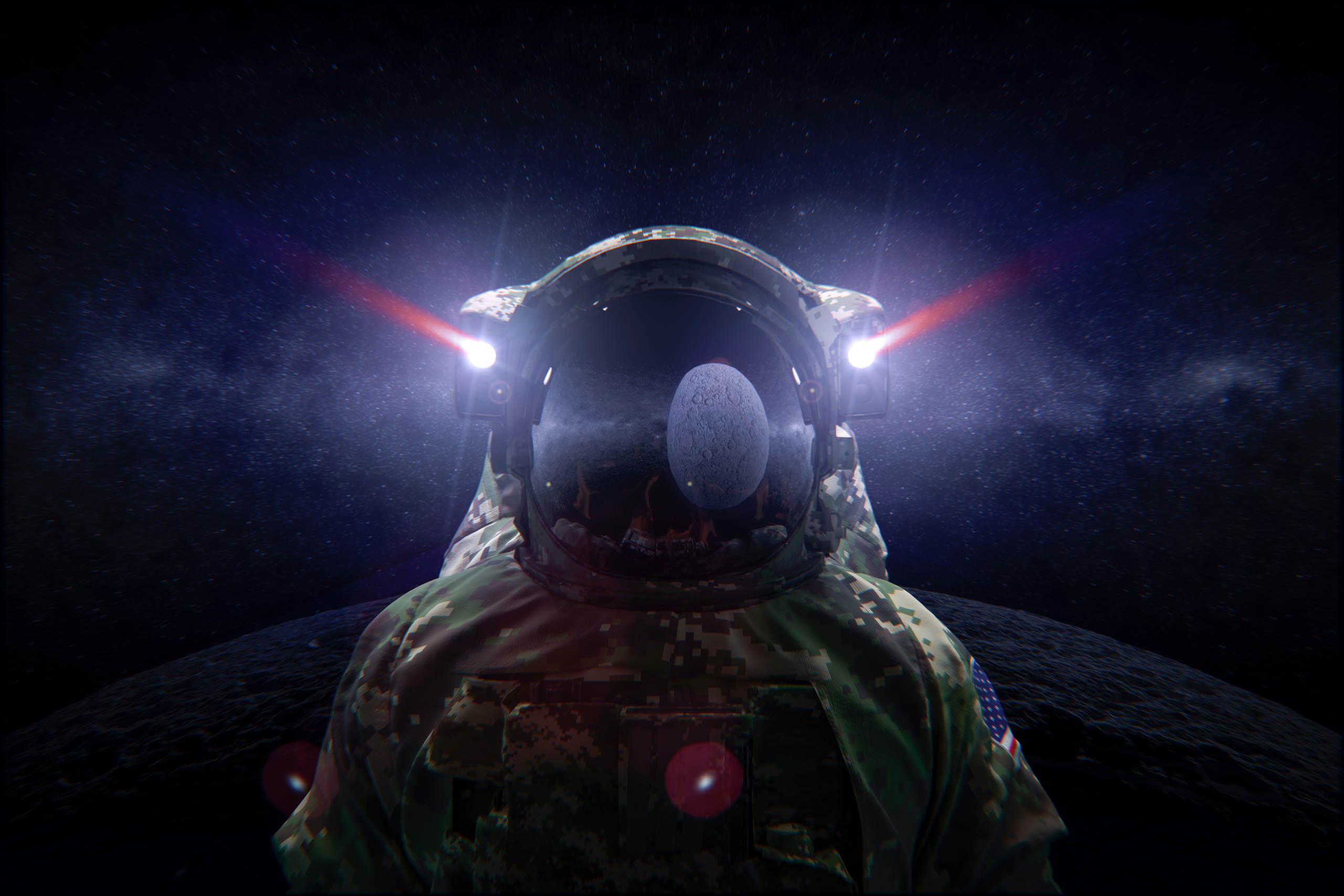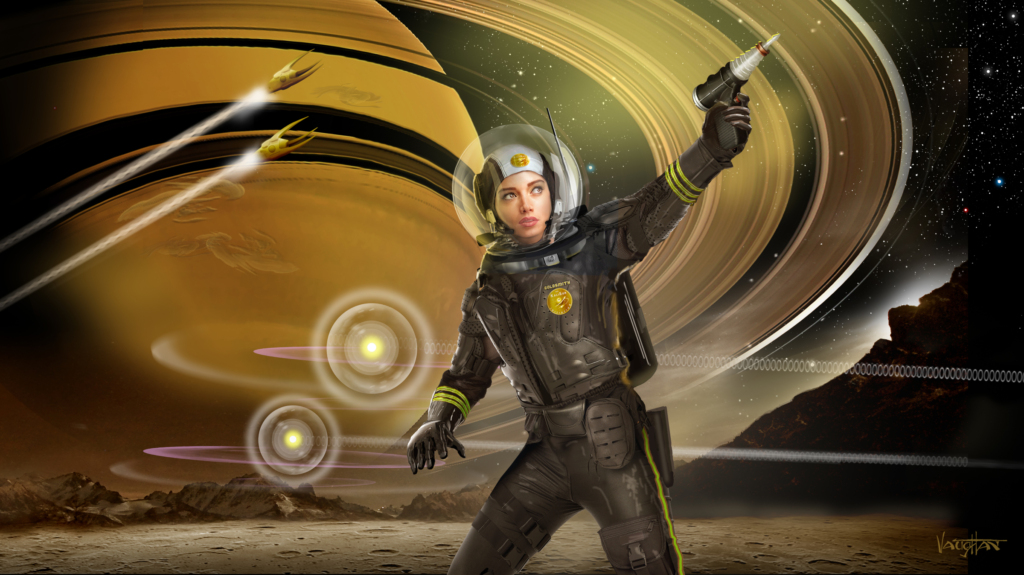By Nathaniel Lee, Hammad Ghazali, Matthew Simpson and Sophia Singer
Abstract
The United States Space Force (USSF) requires diversity of backgrounds and experiences among its officer corps. The current requirement for new USSF space operations officer accessions to possess a science, technology, mathematics or engineering degree stifles diversity of thought and unnecessarily limits the candidate talent pool. The emphasis placed in these degrees is based on the value of technically-oriented skills and engineering-style problem solving. However, these skills are not the exclusive domain of these technical-degree graduates and can also be found in students from other academic disciplines. There are also other skills intrinsic in the humanities, liberal arts, and social sciences that would contribute to the success of the USSF. To prevail in a continually changing environment and to help nurture the intellectual diversity of its Guardians, the USSF should remove the degree requirements and use a comprehensive recruitment process for its space operations officers. The USSF, as a public institution, must strive to leverage the strengths found in modeling the diversity of the nation it serves.
****
“National spacepower requires explorers, diplomats, entrepreneurs, scientists, developers, and warfighters.”
-Space Capstone Publication – “Spacepower”[1]
The United States Space Force (USSF) has an opportunity to tackle a variety of legacy structural and organizational issues in new and innovative ways. One of the most pressing is how the new service identifies and recruits new accessions for its space operations officer career field (13S). Today, only applicants with what are termed “Science, Technology, Engineering, or Mathematics” (STEM) degrees can apply to serve as a 13S.[2] This limitation restricts the demographic and educational diversity of the officer corps, prevents recruitment from the largest pool of potential talent possible, and creates unnecessary barriers to building diversity of thought among future leaders as they seek to build the lethal, agile force that is demanded. Instead of limiting the talent pool for recruitment based on a need for technical competence alone, at the exclusion of other types of competencies that are required for a well-rounded and effective 13S officer corps, the USSF needs to accept all educational fields, assess members individually for aptitude, and develop its training path so that it brings the force to the same technical baseline required for overall mission success.
The styles of thinking that come from a classical liberal arts education and a STEM education are not better or worse, but they are different. In 1959, novelist and scientist C.P. Snow remarked that classical education and scientific education create “two cultures” which began to diverge as specialized education became standard, and which “had so little in common…one might have crossed an ocean.”[3] The USSF requirement for STEM degrees omits not just the people in the “other culture” of liberal arts education, but ideas that are necessary for the success of the force. Assortment of social and educational experiences counters uniformity and is essential to fielding an innovative officer corps to handle the warfighting challenges of a rapidly-changing space domain. To this end, the USSF should remove STEM degree requirements for new 13S officer accessions and begin developing a force-specific officer qualifying test that measures the skills and traits desired in the force.
The USSF relies on the Air Force Officer Classification Directory (AFOCD), which uses the Classification of Instructional Programs (CIP) matrix to define entry education requirements for the 13S career field.[4] CIP codes and associated descriptions are based on a tiered structure: Tiers 1 and 2 include STEM degrees and account for 80% of the accession target, while Tier 3 includes generic bachelors or masters of science degrees.[5] For entry into the 13S career field, an officer accession must meet at least one of the tiers listed within the CIP matrix.[6] When distributing officer accessions across educational needs, Tier 1 requirements are considered first until the pool of available accessions with matching education backgrounds is exhausted.[7] After that, Tier 2 accessions are considered and then Tier 3.[8] While space operations are undoubtedly technical by their very nature, the effective operations of space systems requires more than technical knowledge. The well-intentioned constraint of this degree requirement has significant unintended consequences.
In limiting its new officers to only those with STEM degrees, the USSF unnecessarily restricts the talent pool for 13S, and it deprives the Space Force of the ways of problem solving, thinking, and exploring that come with a classical liberal arts education. It is well documented that STEM educations limit the diversity of graduates, particularly along the lines of gender and ethnicity.[9] These shortages are now being discussed as having significant impacts on the ability for the USSF to recruit the pool of diverse talent needed not only to fill its growing ranks but also to succeed in conflict in the long term.[10]
Aspiring USSF space operations officers who visits the shared USSF/United States Air Force (USAF) recruiting website sees that it lists the educational requirement as “any bachelor or master of sciences degree.”[11] Prior to the space and missiles career field split in 2013, space operations officers were not required to have STEM degrees.[12] Between 2013 and 2015, there was a limited exception possible even if applicants demonstrated some math and science prerequisites.[13] Lieutenant General Chance Saltzman, the current USSF chief operating officer, is a prime example of an officer who serves at the highest levels of the Space Force without a STEM undergraduate or graduate degree.[14] The USAF provided Lieutenant General Saltzman the training and education in STEM-related principles necessary to become among the most successful space operations officers.
The raw materials for aptitude in space-centered warfighting are both innate and acquired, and “space professionals are charged with mastering both space domain knowledge and unique operational art to achieve military purposes.”[15] Tactical theorist B. A. Friedman writes, “the tactician is not a technician.”[16] A successful space operations officer requires more than technical competency.[17] Judgment, critical thinking, wisdom, balance, fairness, proportionality, and a deep sense of human nature in political competition up to and including war all enhance warfighting leadership. To meet personnel end-strength requirements, the USSF could be put in a position where it accepts a STEM-degree holder that is overall less competent in the place of a more competent non-STEM educated individual.[18] The larger the applicant pool, the more selective the force can be, and the better cadre of officer accessions it can cultivate. There is no level of leadership that relies purely on technical ability, and that is even truer at higher levels. Technical experts can learn to be effective leaders, and non-technical experts can also learn to be technically capable.[19]
Restricting 13S accessions to STEM fluency also limits intellectual diversity. There are skills and knowledge from the humanities and social sciences which are essential to successful operations from the tactical to strategic levels. Training in the humanities engenders and hones a set of intellectual skills that are essential to leadership, generalized problem solving, and tactics. The Space Force should value traits such as the ability to interpret and fuse technical data streams, visualize complex trajectories, deconstruct signals based on temporal and spectral properties, and understand the interdependent components of a mission system. It should also value strategic thinking, creative problem-solving, innovation, an understanding of historic military and policy context, and the ability to reflect on the biases and limitations of one’s own worldview, and the opportunities that presents for exploitation to and from its adversaries. Since the USSF receives officers from such a wide range of educational institutions, it is not at all certain that the average humanities or STEM training will be sufficient. Hence, the USSF should measure what it values, blind to formal pedigree. The key for the USSF to access the right talent is decoding the skills needed for making successful and effective space leaders and using formal training to bridge the skills gap as opposed to relying on specific academic backgrounds. As articulated in the Chief of Space Operations’ (CSO) Planning Guidance, “our small, flat organization allows for deliberate individualized development focused on building space warfighters with the necessary experience and skills to prevail in combat.”[20]
The USSF wants a force that thinks strategically, understands history, military doctrine, and policy.[21] It needs to recruit and develop members who have formally studied these subjects. The USSF published its first doctrinal primer, Space Capstone Publication (SCP) in early 2020. In addition to warfighting doctrine for the new domain, the document revealed leadership traits needed for current and future USSF leaders, based on the principle that space warfare is both a science and an art. Leaders of military space professionals require a combination of situational awareness, technical mastery, and an ability to think critically while working under the constraints of outer space. The science of space warfare enables us to exploit the physics of the space domain for military advantage whereas the art of space warfare provides insight into the human elements of warfare, including leadership, operational art, uncertainty, emotion, will to fight, adaptation, and cunning. SCP relates that “we must be fluent in Kepler and Clausewitz, Maxwell and Sun Tzu, Goddard and Corbett and Mahan, as well as Newton and Liddell Hart.”[22] By itself, the science of space warfare is agnostic to its application and has limited utility. It is the art of space warfare that gives science its relevance; combined, the art and science teach us how to fight and win.[23] Therefore, space leaders must learn and practice the science and art of space mastery and warfighting. In addition, leaders must be strategic thinkers who can properly consider long-term impacts and technical experts who can comprehend the complex systems and mission.[24] Ultimately, the USSF needs leaders who are guided by agility, innovation, and boldness regardless of their backgrounds, experience, and skills.
An argument can be made that the STEM degree requirement is in place to ensure a technically competent force, and that space missions “by their very nature . . . require high-level STEM capabilities.”[25] On its face, the argument makes sense from a technological aspect: space systems and their operations are technology-driven, so the force must be technically literate in order to operate them successfully. But this technocratic perspective excludes several key lessons learned from other U.S. military force development activities, and looking at other USAF and USSF career fields and their educational requirements sheds further light on the problem of the STEM degree requirement. Enlisted Space Operators (1C6) in all combat disciplines are expected to perform technically demanding duties, including “develop[ing] in-depth, technical knowledge and skills, to the sub-system level, on individual weapon systems and their associated support infrastructure,” and yet there is no degree requirement for them because they are effectively trained for these jobs.[26] Likewise, the USAF 11F pilot community does not have a particular degree requirement, yet their duties entail becoming technical experts in their complex weapons systems (among many other things).[27] An 11F must be intimately familiar with how their aircraft performs, but they are not required to possess any formal technical or scientific education, not even a mandated percentage. Again, they are sourced from a wide variety of backgrounds, they are screened for aptitude through the rated sections of the Air Force Officer Officer Qualifying Test (AFOQT), and the USAF gives them the training required to succeed.
There is another potential counterargument that a STEM degree, regardless of a specific field, provides new 13S with a general understanding of scientific principles that enable faster learning of other scientific principles in other fields. It also allows the service to capitalize on STEM education, alleviating the need to train officer accessions in advanced scientific and engineering topics. While this may be true, the USSF will remain a lean enough force in the near future that applicants can be chosen selectively, and that aptitude can be a general quality sought out in recruits. Most bachelor’s degrees require some baseline of science and math courses as part of a “general education” requirement. Even today, there are 13S leaders who are classically trained and succeed because they possess the ability to learn the necessary technical information for their duties, and because they bring different ways of observing situations, orienting to problems, analyzing courses of action, and executing solutions.
Finally, this proposal is also scoped only to 13S. Shared Air Force Specialty Codes, most critically 62X, should remain technical experts in their disciplines and provide the force with not only engineering academics backgrounds but also professionals who remain steeped in engineering practices.[28] The Air Force Studies Board report on the needs of STEM in the USAF also identified that for space, “both warrior and technical (STEM-degreed or STEM-cognizant) skills” are required.[29]
* * *
“We do not know which future visionaries will emerge to follow in the footsteps of leaders like Schriever.”[30]
– Chief of Space Operations, General John W. Raymond
Accepting applicants from all educational backgrounds is critical toward developing the officer corps the USSF needs. Removing the specialized degree requirement enables the force to craft its recruitment, training, and retention programs to mold and employ the right group of officers. The USSF is forecasted to remain lean enough of an organization that recruitment and applicant screening can be handled more selectively, with review of resumes, interviews, letters of recommendation, and transcripts all contributing to the “whole person” review process, much in the same way colleges themselves have pivoted to comprehensive assessments of who they accept.[31] A person with a college degree in English literature but having taught themselves to code and has been working full time as a software developer, to a prior-enlisted radio frequency transmissions operator who earned their degree in homeland Security, but is a well-established space operations expert, would be denied a career as a 13S despite being well-qualified when looked at holistically. Air Force Instruction 36-3701, Space Professional Development Program, states that “mission effectiveness demands technologically sound personnel; sustained by career-long education in applicable science, engineering, application, theory and doctrine.”[32] This emphasis on the blending of raw science, its applications, and how it fits into larger military philosophy is why a wide range of educational backgrounds is necessary.
These changes to recruitment practices also enable the continued refinement of training pipelines for new officers. While Undergraduate Space Training, the Space Warfighter Follow-On courses, and other training paths that have been developed in the last couple of years have made great strides in improving the rigor of their curricula, the USSF is still learning about how operations in these newly-defined domains will work today and into the future.[33] The true level of STEM-cognizance required for success as a space operations officer is not quantifiable because these training programs never had to develop a baseline to teach to, because all of the members were already deemed to be “STEM qualified” based on educational requirements.[34] As the force continues to uncover new lessons about operations and mission effectiveness across military space broadly, and within the specific spacepower disciplines, it can continue to update the formal training path to best incorporate that learning. The USSF needs a broader educational base because it is still developing its core competencies. The USSF should not restrict the accession of otherwise talented individuals when the core competencies remain undefined and are still being learned. This restriction limits the ability for the force to do that learning by scoping its applicants along narrow degree requirements.
The USSF will require leaders with diverse backgrounds, experiences, and educational foundations to become the agile, innovative, strategic, and lethal military service required to meet the growing demands of national security space. Eliminating the STEM degree requirement is a necessary first step toward accomplishing that goal. While this change alone is not sufficient to create the cadre of officers the service needs, it enables the potential for many other elements of leadership development to flourish. A larger group of potential recruits allows the force to be more selective, which opens opportunities for new ways to evaluate potential capabilities. A diverse set of educational experiences requires that the accession training pipeline truly meet the requirements of the force. If the USSF limits its talent pool in this unnecessarily restrictive way, it will never be able to truly achieve the force capability that the defense of this country requires, reflect the diverse strengths of the United States, and protect American interests in, through, and from space.
Captain Nathaniel Lee, USSF, is the Branch Chief for Enabling Capabilities at the Space Security and Defense Program. Captain Hammad Ghazali, USSF, is the Executive Officer for Director, Combat Power supporting Orbital Warfare, Electronic Warfare, Space Domain Awareness and Cyber Operations mission areas. Captain Matthew Simpson, USSF, is the Weapons and Tactics Flight Commander for the 527th Space Aggressor Squadron. Captain Sophia Singer, USSF, is the Mission Integration Lead for Detachment 1 supporting the Delta 9 mission. This paper represents solely the authors’ views and do not necessarily represent the official policy or position of any Department or Agency of the U.S. Government. If you have a different perspective, we’d like to hear from you.
NOTES
- Space Capstone Publication – Spacepower (2020), 48, https://www.spaceforce.mil/Portals/1/Space%20Capstone%20Publication_10%20Aug%202020.pdf. ↑
- “Space Operations Officer,” U.S. Air Force, accessed July 13, 2021, https://www.airforce.com/careers/detail/space-operations-officer. ↑
- C.P. Snow, The Two Cultures and the Scientific Revolution (Mansfield Center: Martino Publishing, 2013), 2-3. ↑
- Air Force Personnel Center, Officer Classification Directory (2021), 263, accessed July 13, 2021, file:///C:/Users/1057686606A/OneDrive%20-%20United%20States%20Air%20Force/Desktop/AFOCD-%2030%20Apr%202021v3%20(1).pdf. ↑
- Ibid. ↑
- Ibid. ↑
- Ibid. ↑
- Ibid. ↑
- Richard Fry, Brian Kennedy, and Cary Funk, “Stem Jobs See Uneven Progress in Increasing Gender, Racial and Ethnic Diversity,” Pew Research Center, April 1, 2021, https://www.pewresearch.org/science/2021/04/01/stem-jobs-see-uneven-progress-in-increasing-gender-racial-and-ethnic-diversity/. ↑
- Bryan Stewart and Raj Agrawal, “OverSTEMulated: The Science and Art of Space Power Leadership,” Air and Space Power Journal 35, no. 2 (June 29, 2021): 55-64, https://www.airuniversity.af.edu/Portals/10/ASPJ/journals/Volume-35_Issue-2/F_Stewart_Agrawal.pdf.; Jason Lyall, Divided Armies: Inequality and Battlefield Performance in Modern War (Princeton: Princeton University Press, 2020), 1-38. ↑
- Space Operations Officer. ↑
- Air Force Personnel Center, Officer Classification Directory (2013), 68, https://www-s3-live.kent.edu/s3fs-root/s3fs-public/file/afocd_2013_october.pdf. ↑
- Air Force Personnel Center, Officer Classification Directory (2015), 258, https://afrotc.siu.edu/_common/documents/af-officer-classification-directory-2015.pdf. ↑
- Stewart and Agrawal; “Lieutenant General b. Chance Saltzman,” U.S. Air Force Biographies, accessed July 13, 2021, https://www.af.mil/About-Us/Biographies/Display/Article/838884/lieutenant-general-b-chance-saltzman/. ↑
- Chief of Space Operations’ Planning Guidance (2020), 5, https://media.defense.gov/2020/Nov/09/2002531998/-1/-1/0/CSO%20PLANNING%20GUIDANCE.PDF. ↑
- B.A. Friedman, On Tactics: A Theory of Victory (Annapolis: Naval Institute Press, 2017), 2. ↑
- Ibid, 2-3. ↑
- Stewart and Agrawal, 56. ↑
- Art Markman, “Can You Be a Great Leader Without Technical Expertise?,” Harvard Business Review, November 12, 2017, https://hbr.org/2017/11/can-you-be-a-great-leader-without-technical-expertise. ↑
- Chief of Space Operations’ Planning Guidance, 6. ↑
- Ibid, 5. ↑
- Space Capstone Publication, 59. ↑
- Ibid, 47. ↑
- Chief of Space Operations’ Planning Guidance, 5. ↑
- “Examination of the U.S. Air Force’s Science, Technology, Engineering, and Mathematics (STEM) Workforce Needs in the Future and Its Strategy to Meet Those Needs,” The National Academies Press, accessed July 13, 2021, https://www.nap.edu/read/12718/chapter/4#21. ↑
- Department of the Air Force, AFSC 1C6 Career Field Education and Training Plan (2016), 27. ↑
- Officer Classification Directory (2021), 29. ↑
- Ibid, 275-276. ↑
- National Academies Press, 22. ↑
- John Raymond, “Chief of Space operations’ Planning Guidance,” The Atlantic, December 20, 2020, https://www.theatlantic.com/ideas/archive/2020/12/building-21st-century-space-force/617434/. ↑
- “5 Things You Need to Know About College Admission,” The College Board, accessed July 13, 2021, https://bigfuture.collegeboard.org/get-in/applying-101/5-things-you-need-to-know-about-college-admission. ↑
- Secretary of the Air Force, AFI 36-3701 Space Professional Development Program (2010), 13, accessed 13 July, 2013, https://www.my.af.mil/gcss-af/USAF/AFP40/d/s6925EC1346920FB5E044080020E329A9/Files/editorial/AFI%2036-3701,%20Space%20Professional%20Development%20Program%20(20%20May%202010).pdf?programId=t2D8EB9D63B0615A3013B0A5AA48C005E. CAC REQUIRED. ↑
- “Orbital Engagement Maneuvers Advanced Course,” 319th Combat Training Squadron, accessed July 13, 2021, https://www2.peterson.af.mil/asops/CESET/asops/courses-OEM-AC.htm. ↑
- Officer Classification Directory (2021), 263. ↑





